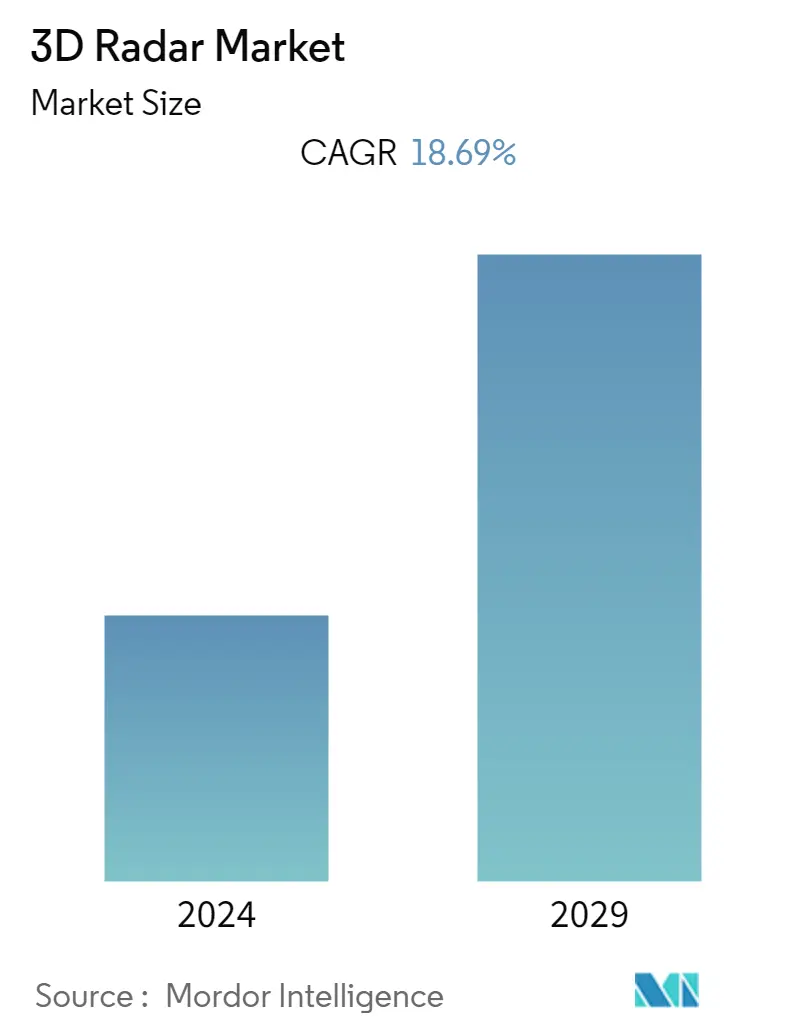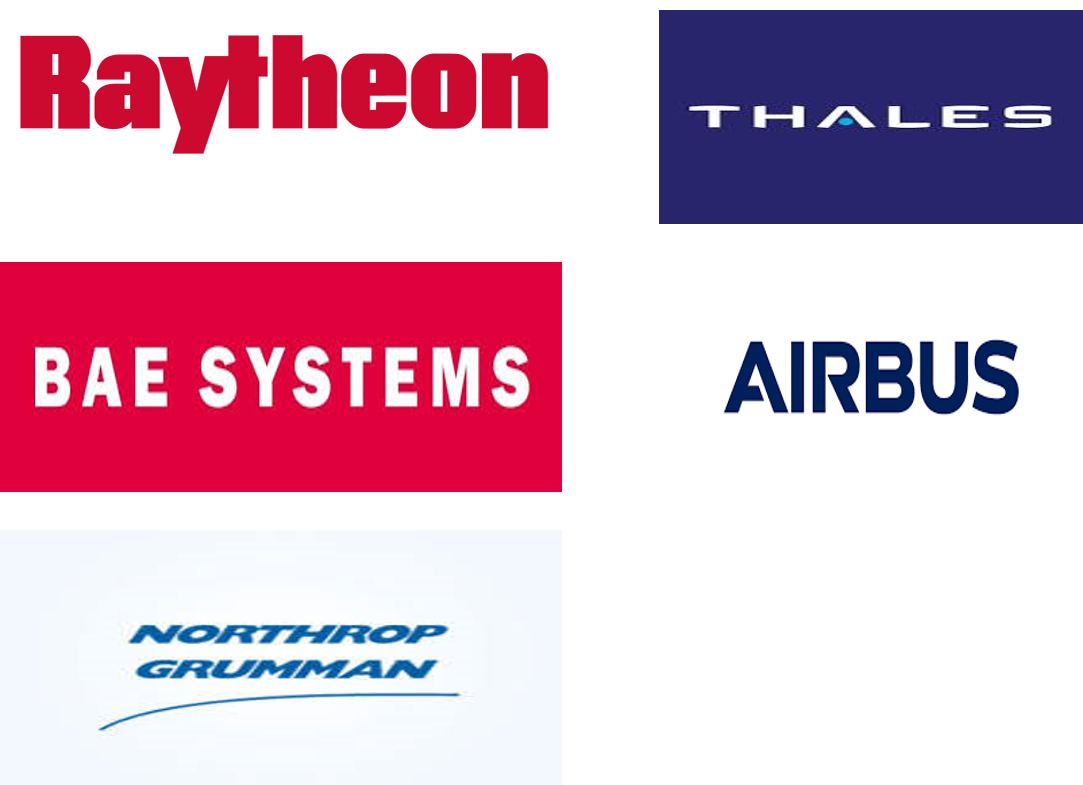Market Size of 3D Radar Industry

| Study Period | 2019 - 2029 |
| Base Year For Estimation | 2023 |
| CAGR | 18.69 % |
| Fastest Growing Market | Asia Pacific |
| Largest Market | North America |
| Market Concentration | Low |
Major Players
*Disclaimer: Major Players sorted in no particular order |
3D Radar Market Analysis
The 3D radar market was valued at USD 926.19 million in 2020 and is expected to reach USD 2586.42 million by 2026, recording a CAGR of 18.69%, during the forecast period of 2021-2026. Trends in miniaturization of 3D radars are expected to offer lucrative opportunities for the market.
- Further, according to the International Air Transport Association, of the 316 accidents that occurred during 2014-2018, 31% may have been prevented by improving the regulatory oversight of the operator's state. Air traffic management (ATM) becomes of critical importance for maintaining safe and collision-free operation and for smooth operations 3D radar is the long-term solution, thus fueling the growth of the use of 3D radar systems.
- Moreover, the spending in the military warfare systems is expected to complement the market opportunity for the 3D radar systems, supporting infrastructure for detecting small flying or trespassing objects.
- However, high installation cost and skilled expertise are required for operating and maintaining the system are some factors that might hinder the growth of 3D radar market.
3D Radar Industry Segmentation
3D radar provides for radar coverage in three dimensions with elevation information with range and azimuth. The 3D radar market has been segmented based on the platform, range, band and geography.
| By Platform | |
| Airborne | |
| Ground | |
| Naval |
| By Range Type | |
| Long Range | |
| Medium and Short Range |
| Geography | ||||||
| ||||||
| ||||||
| ||||||
| ||||||
| Rest of the World |
3D Radar Market Size Summary
The 3D radar market is poised for significant growth, driven by advancements in technology and increasing demand across various sectors. The market is experiencing a surge in interest due to the miniaturization of radar systems, which presents lucrative opportunities for expansion. The critical role of 3D radar in air traffic management and military applications underscores its importance in ensuring safety and operational efficiency. Despite challenges such as high installation costs and the need for skilled expertise, the market is bolstered by the growing defense budgets and the need for advanced surveillance capabilities. The integration of 3D radar systems in unmanned aircraft systems further enhances their appeal, as these systems are increasingly used for surveillance and military operations.
The Asia-Pacific region is expected to witness the fastest growth in the 3D radar market, driven by factors such as increasing sea crimes, border tensions, and the adoption of marine transport. The region's defense spending and focus on research and development in radar technologies are key contributors to this growth. Companies like Tata Power SED are expanding their presence by supplying advanced radar systems to military forces, such as the Indian Navy. The competitive landscape is characterized by major players like Northrop Grumman, Raytheon, and Airbus Defense and Space, who are actively developing specialized radar solutions for various applications. Recent developments, such as Saab's Giraffe 1X Radar and Echodyne's EchoGuard, highlight the ongoing innovation and strategic partnerships shaping the market's future.
3D Radar Market Size - Table of Contents
-
1. MARKET DYNAMICS
-
1.1 Market Overview
-
1.2 Market Drivers
-
1.2.1 Rising Use of 3D Radar in Unmanned Aerial Vehicles
-
-
1.3 Market Restraints
-
1.3.1 High Initial Deployment Cost
-
-
1.4 Industry Value Chain Analysis
-
1.5 Industry Attractiveness - Porter's Five Force Analysis
-
1.5.1 Threat of New Entrants
-
1.5.2 Bargaining Power of Buyers/Consumers
-
1.5.3 Bargaining Power of Suppliers
-
1.5.4 Threat of Substitute Products
-
1.5.5 Intensity of Competitive Rivalry
-
-
-
2. MARKET SEGMENTATION
-
2.1 By Platform
-
2.1.1 Airborne
-
2.1.2 Ground
-
2.1.3 Naval
-
-
2.2 By Range Type
-
2.2.1 Long Range
-
2.2.2 Medium and Short Range
-
-
2.3 Geography
-
2.3.1 North America
-
2.3.1.1 United States
-
2.3.1.2 Canada
-
-
2.3.2 Europe
-
2.3.2.1 United Kingdom
-
2.3.2.2 Germany
-
2.3.2.3 France
-
2.3.2.4 Rest of Europe
-
-
2.3.3 Asia-Pacific
-
2.3.3.1 China
-
2.3.3.2 Japan
-
2.3.3.3 India
-
2.3.3.4 Rest of Asia-Pacific
-
-
2.3.4 Middle East and Africa
-
2.3.4.1 United Arab Emirates
-
2.3.4.2 Saudi Arabia
-
-
2.3.5 Rest of the World
-
-
3D Radar Market Size FAQs
What is the current 3D Radar Market size?
The 3D Radar Market is projected to register a CAGR of 18.69% during the forecast period (2024-2029)
Who are the key players in 3D Radar Market?
Northrop Grumman Corporation, Raytheon Company, Thales Group, BAE Systems PLC and Airbus Defense and Space are the major companies operating in the 3D Radar Market.

